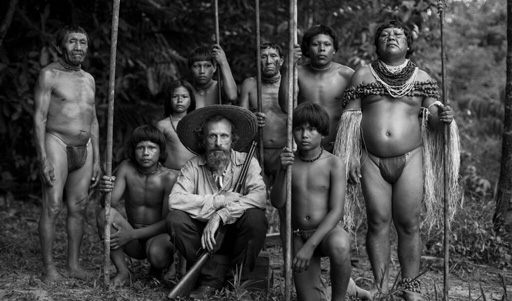
Inter-species interaction between outer space aliens and human beings has long been a staple of the science fiction genre, as in 1951’s The Day the Earth Stood Still and its 2008 remake, 1977’s Close Encounters of the Third Kindand 1982’s E.T. Roswell, et al, notwithstanding, the jury is still out as to whether or not Earthlings have actually encountered extraterrestrials. Be that as it may, the closest counterpart to this cross-cultural experience is the first contact between so-called “primitive” aboriginal peoples and self-styled “superior” civilizations, often wielding more advanced technology.
That these inter-“racial” rendezvous have a sci-fi vibe is attested to by the Samoan word for Caucasians: When the sail of navigator Jacob Roggeveen’s Dutch West India Company ship appeared over Samoa’s horizon in 1722, it appeared that the foreign visitors in their strange-looking UFO were “bursting the sky.” To this day Samoans call white people “palagi” (shortened from “papalagi“), which literally means “sky burster.”
Colombian director/co-writer Ciro Guerra’s Embrace of the Serpent– Colombia’s official Oscar entry for the Best Foreign Language category – is the latest in a long line of works of art dealing with early contact between indigenous people and foreigners from afar. Before the cinema, literature pondered these often fatal interchanges in novels such as James Fenimore Cooper’s 1826 The Last of the Mohicans and Joseph Conrad’s 1899 novella Heart of Darkness (Francis Ford Coppola’s 1979 Apocalypse Now brilliantly reset Conrad’s Congo saga in Indochina). The 1995 animated feature Pocahontas is an archetypal depiction of this culture clash and intermingling.
The initial arrivers – who are usually Westerners – to pristine Third World lands include explorers, missionaries, sailors, soldiers, settlers, traders, anthropologists and the like. Although these outsiders typically view themselves as savers of souls and bringers of civilization, their self-appointed, self-anointed role in carrying out what Rudyard Kipling, the poet laureate of racism and colonialism, dubbed the “white man’s burden” usually makes them, in practice, uninvited, unwelcome imperial intruders and interlopers.
In Embrace of the Serpent the Westerners on twin voyages of discovery in Colombia’s deepest, darkest Amazon are both real-life scientists. Guerra’s film, co-written by Bogotá-born Jacques Toulemonde Vidal, is based on their journals. Theodore Koch-Grünberg (Jan Bijvoet) is a driven German ethnologist who roamed around the Amazon circa 1909. (Germany has had a long fascination with anthropology, as well as a pre-World War I empire stretching from Oceania to Africa. Dr. Augustin Krämer’s early 20th-century books about Palau remain highly regarded.)
Serpent‘s other man of science is American Richard Evans Schultes (Brionne Davis), who traveled to the Colombian Amazon rain forest in the 1940s. Considered “the father of ethnobotany,” the New York Times called Schultes “a real life Indiana Jones” and “swashbuckling scientist” in its 2001 obituary. In his 1985 book The Serpent and the Rainbow Wade Davis called Schultes, ”The last of the great plant explorers….” Schultes was also one of the psychedelic Sixties’ pioneers of hallucinogens who co-authored 1979’s The Plants of the Gods: Their Sacred, Healing, and Hallucinogenic Powers with Swiss chemist Albert Hofmann, who took the first LSD trip.
Indeed, Schultes, like Koch-Grünberg before him, is on a quest for the rare, hard-to-find yakruna plant, which reputedly has great mind expanding attributes – it is the silver chalice of psychedelia. If in Serpent Schultes and Koch-Grünberg play the role of Cooper’s Hawkeye or Conrad’s Marlow, the Amazonian shaman Karamakate is similar to Uncas, the last pure-blooded Mohican in Cooper’s novel.
Karamakate is a fascinating character, a “noble savage” similar to Melville’s harpooner Queequeg in Moby-Dick, a child of nature who lives as one with the rain forest and possesses mystical insights. Karamakate believes he is the last surviving member of his tribe, which has been ravaged by its contacts with “whitey,” in particular the rubber plantation barons who have enslaved Amazonian natives – hence his solitary existence in the jungle. The sorcerer claims to know where the last yakruna is. On the other hand Koch-Grünberg purports that other Cohiuano – the tribe Karamakate thinks is extinct – still exist and the German contends he can lead the South American Indian back to his long-lost people. In exchange for doing so Karamakate agrees to take Koch-Grünberg to the last remaining yakruna plant.
Thirty-plus years later Schultes embarks on the same yakruna odyssey. Serpent cuts back and forth from his journey to that of Koch-Grünberg’s sojourn. It turns out that both have the same guide – Karamakate as a young man (portrayed by Nilbio Torres) and Karamakate as an elder (played by Antonio Bolívar). The intercutting across the decades of the twin stories does not make this fact very clear, but Guerra may do this deliberately to express the notion that Amazonia’s tribal peoples possess a different sense of time than Westerners have.
Both white men have their ups and downs with their versions of the loincloth-wearing Karamakate, who distrusts outsiders, due to the eco-havoc foreigners have wreaked upon the Amazon and its plant, human and animal inhabitants. These bumpy relationships mirror South America’s troubled history of race relations.
Serpent‘s stunning cinematography is (mostly) in glorious monochromatic black and white. However, as splendid as it looks, shot on location for seven weeks in the jungles at Vaupés in Colombia’s remote Amazonas region, I wished Serpent had been lensed in living color. This way viewers could experience the rain forest’s vivid colors, as in John Boorman’s aptly named 1985 The Emerald Forest shot in the Brazilian Amazon and Werner Herzog’s 1982 Fitzcarraldo, with its Peru and Brazil locations.
Well-directed, Serpent is also well-acted, but the standout in the cast largely composed of members of Vaupés’ tribes is Cubeo tribesman Nilbio Torres. In true Neo-realist style, Torres never acted before, but with the authenticity he brings to his role, this Amazonian is amazing. As press notes put it, the buff Torres “has never set foot in a gym; his amazing physique has been sculpted by the hardships of the jungle….” A gifted actor, this newcomer deserves a Best Actor Oscar nomination.
Also according to press notes, Serpent is “the first Colombian film to feature an indigenous protagonist and to be told from his perspective.” According to Guerra’s director’s statement: “The explorers have told their story. The natives haven’t. This is it.”
In a New Yorker article about Schultes he was quoted as saying: “All that is required to bring out their gentlemanliness is reciprocal gentlemanliness. I do not believe in hostile Indians.” Indeed, the versatile Torres and Bolívar alternate between gentility and fierceness in their depictions of the younger and older Karamakate.
The Westerners’ search for the sacred yakruna plant parallels Karamakate’s quest for his lost tribesmen. The film culminates with a psychedelic sequence in color, evocative of an acid trip that is reminiscent of the grand finale near the end of Stanley Kubrick’s 2001: A Space Odyssey.
This subtitled, 125-minute epic odyssey runs the gamut, covering deracination, acculturation, colonization, religious zealotry, the return to nature, the indigenous struggle for survival and much more. What a wild ride and long, strange trip it is.
Embrace of the Serpent will be theatrically released in New York on Feb. 17 and Los Angeles on Feb. 19, with a national rollout to follow. For more info see: http://embraceoftheserpent.vhx.tv/.












Comments